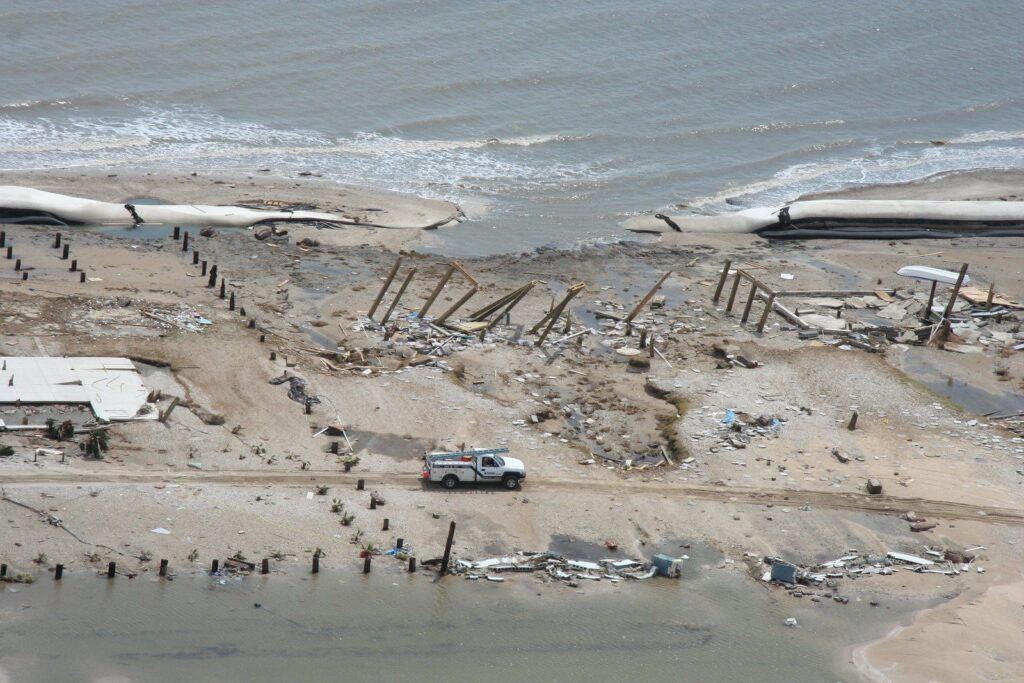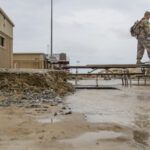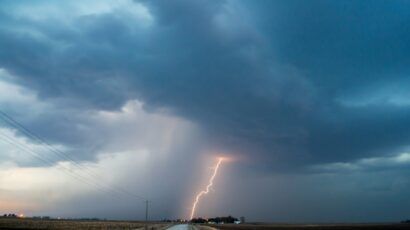In a nod to resiliency, FEMA will take climate change into account when rebuilding
By Jake Bittle | July 11, 2024
 The aftermath of 2008’s Hurricane Ike on the Bolivar Peninsula in Texas. Image courtesy of NOAA.
The aftermath of 2008’s Hurricane Ike on the Bolivar Peninsula in Texas. Image courtesy of NOAA.
Editor’s note: This story was originally published by Grist. It appears here as part of the Climate Desk collaboration.
When the Federal Emergency Management Agency (FEMA) spends millions of dollars to help rebuild schools and hospitals after a hurricane, it tries to make the community more resilient than it was before the storm. If the agency pays to rebuild a school or a town hall, for example, it might elevate the building above the floodplain, lowering the odds that it will get submerged again.
That sounds simple enough, but the policy hinges on a deceptively simple question: How do you define “floodplain”? FEMA and the rest of the federal government long defined it as an area that has a 1 percent chance of flooding in any given year. That so-called 100-year floodplain standard, though more or less arbitrary, has been followed for decades — even though thousands of buildings outside the floodplain go underwater every year.
Now FEMA is expanding its definition of the floodplain, following an executive order from President Joe Biden that forced government agencies to tighten rules about how they respond to the increasing risk of floods. In a significant shift, the new standard will require the agency to factor in the impact of climate change on future flood risk when it decides where and how it’s safe to build.
The new rule will result in higher-elevated and better-fortified buildings, and could help break a cycle of destruction and reconstruction that has cost the government billions of dollars over the past few decades. In a press conference announcing the rule, FEMA administrator Deanne Criswell hailed it as a significant change in how the government responds to disasters.
The rule “will allow us to enhance resilience in flood-prone communities by taking future flood risk into consideration when we rebuild structures post-disaster,” she said. “This is a huge win that will also allow us to end the repeat loss cycles that stem from flooding and increase the safety of families and save taxpayer dollars.”
Under the new rule, the agency will “integrate current and future changes in flooding based on climate science” when it estimates flood risk, factoring in sea level rise and intensified erosion that will get worse over the course of the century. This will be easiest in coastal areas, where the science about sea level rise and flooding is well established. In riverine areas, where science is less robust, the agency will rebuild at least as high as the 500-year floodplain, or the land that has less than a 0.2 percent chance of flooding in a given year—and sometimes even higher for essential infrastructure such as bridges and hospitals.
This is a dramatic shift from previous measurements, which relied on historical data to estimate future flooding. Because climate change has intensified since the collection of that initial data, previously the agency was systematically underestimating climate-related risk. Therefore, the new system assumes that flood risk is much higher than in the past, and that it will keep rising as time goes on. To mitigate that risk, FEMA will build farther from the water wherever possible and will raise structures on stilts and pilings when it can’t pull back from the coast.
“The federal government really has a duty to account for a future flood risk when it’s providing funding to build or rebuild homes or infrastructure, because it’s using taxpayer dollars,” said Joel Scata, a senior attorney at the nonprofit Natural Resources Defense Council and an expert on flood policy. Under the new rule, he said, FEMA is “going to be building in a way that’s not setting people and infrastructure up for future failure.”
FEMA has estimated that elevating and flood-proofing structures at this stricter standard could cost the agency as much as an additional $150 million over the next ten years — a proportionally small sum given the agency’s $3 billion annual disaster spending. The agency says that elevating structures by 2 additional feet adds around 2 percent to the cost of the average project, but that this spending will pay for itself over the next 60 years by preventing future damages.
There could still be trickle-down costs for local governments, which often have to pay around 25 percent of the cost when FEMA repairs a damaged school or installs a flood barrier in a community. Many small towns and low-income communities have struggled to provide these matching funds, and they have been excluded from federal resilience grants as a result.
The Biden administration is not the first to consider the 100-year floodplain standard inadequate. Then-President Barack Obama tried to expand the definition after Superstorm Sandy in 2012, but the Trump administration scrapped this revised standard just after taking office. President Biden’s rule has now advanced farther along in the regulatory process than the Obama administration’s rule was able to, which will make it much harder for a potential second Trump administration to repeal it.
Local updates to floodplain standards have already shown results: Houston, Texas, saw three massive floods in consecutive years between 2015 and 2017. After Hurricane Harvey struck in 2017, the city updated its building regulations to prohibit construction in the 500-year floodplain, forcing builders to elevate homes much higher or build farther back from rivers and streams. These standards likely prevented thousands of homes from flooding earlier this week during Hurricane Beryl, which caused several rivers and bayous to overflow and spill onto surrounding land.

Together, we make the world safer.
The Bulletin elevates expert voices above the noise. But as an independent nonprofit organization, our operations depend on the support of readers like you. Help us continue to deliver quality journalism that holds leaders accountable. Your support of our work at any level is important. In return, we promise our coverage will be understandable, influential, vigilant, solution-oriented, and fair-minded. Together we can make a difference.
Keywords: climate crisis, extreme weather, global warming, hurricanes, resiliency
Topics: Climate Change















